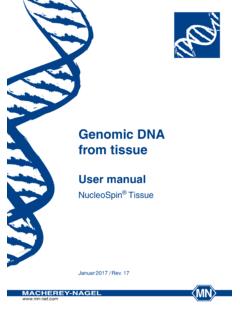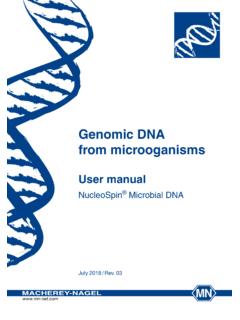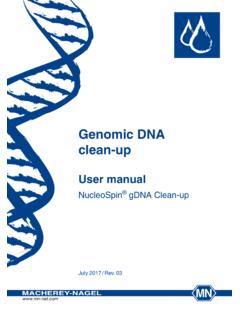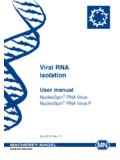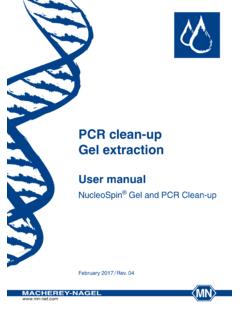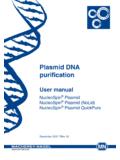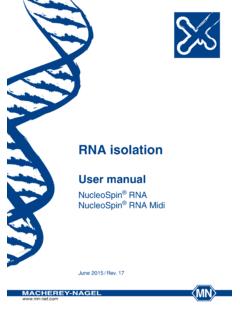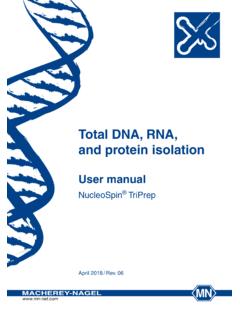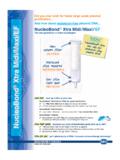Transcription of Genomic DNA from tissue - mn-net.com
1 US:Tel.: +1 484 821 0984 Fax: +1 484 821 1272 E-mail: GmbH & Co. KG Neumann-Neander-Str. 6 8 52355 D ren / International:Tel.: +49 24 21 969-0 Fax: +49 24 21 969-199 E-mail: +41 62 388 55 00 Fax: +41 62 388 55 05 E-mail: +33 388 68 22 68 Fax: +33 388 51 76 88 E-mail: GmbH & Co. KG Neumann-Neander-Str. 6 8 52355 D ren / International:Tel.: +49 24 21 969-0 Fax: +49 24 21 969-199 E-Mail: +41 62 388 55 00 Fax: +41 62 388 55 05 E-Mail: +33 388 68 22 68 Fax: +33 388 51 76 88 E-Mail: ISO 9001 ZERTIFIZIERTMACHEREY-NAGEL GmbH & Co. KG Neumann-Neander-Str. 6 8 52355 D ren / International:Tel.: +49 24 21 969-0 Fax: +49 24 21 969-199 E-Mail: +41 62 388 55 00 Fax: +41 62 388 55 05 E-Mail: +33 388 68 22 68 Fax: +33 388 51 76 88 E-Mail: ISO 9001 ZERTIFIZIERTG enomic DNA from tissueUser manualNucleoSpin tissue XSOctober 2017 / Rev.
2 08 MACHEREY-NAGEL GmbH & Co. KG Neumann-Neander-Str. 6 8 52355 D ren GermanyTel.: +49 24 21 969-270 Fax: +49 24 21 969-199 DNA from tissue Protocol-at-a-glance (Rev. 08)NucleoSpin tissue XS1 Prepare sampleUp to mg tissue2 Pre-lyse sample80 L T18 L Proteinase K56 C, 1 4 h3 Lyse sample80 L B370 C, 5 min4 Adjust binding conditions80 L ethanol5 Bind DNALoad lysate11,000 x g, 1 min6 Wash silica membrane1st wash50 L B511,000 x g, 1 min2nd wash50 L B511,000 x g, 2 min7 Elute DNA20 L BE11,000 x g, 1 min8 Optional: Remove residual ethanolOptional:90 C, 8 min3 MACHEREY-NAGEL 10/2017, Rev. 08 Genomic DNA from TissueTable of contents1 Components Kit contents Reagents, consumables.
3 And equipment to be supplied by user About this user manual 52 Product description The basic principle Kit specifications Handling of sample material Elution procedures Removal of residual traces of ethanol for highest sensitivity in downstream applications 93 Storage conditions and preparation of working solutions 114 Safety instructions 125 Protocols Protocol for human or animal tissue Protocol for cultured cells Protocol for paraffin-embedded tissue Protocol for dried blood spots (Guthrie cards) Protocol for buccal swabs Protocol for laser-microdissected tissue Protocol for blood samples 256 Appendix Troubleshooting Ordering information Product use restriction / warranty 27 MACHEREY-NAGEL 10/2017, Rev.
4 084 Genomic DNA from Tissue1 Components Kit contentsNucleoSpin tissue XS10 preps50 preps250 Buffer T1 5 mL10 mL50 mLLysis Buffer B310 mL10 mL60 mLWash Buffer B5 (Concentrate)* 6 mL6 mL6 mLElution Buffer BE**13 mL13 mL13 mLProteinase K (lyophilized)*6 mg20 mg2 x 50 mgProteinase Buffer mL8 mLNucleoSpin tissue XS Columns (green rings)1050250 Collection Tubes (2 mL)20100500 User manual111* For preparation of working solutions and storage conditions see section 3.**Composition of Elution Buffer BE: 5 mM Tris/HCl, pH 10/2017, Rev. 08 Genomic DNA from Reagents, consumables, and equipment to be supplied by userReagents 96 100% ethanolConsumables mL microcentrifuge tubes for sample lysis and DNA elution Disposable tipsEquipment Manual pipettors Centrifuge for microcentrifuge tubes Vortex mixer Thermal heating-block Personal protection equipment (lab coat, gloves, goggles) About this user manualIt is strongly recommended reading the detailed protocol sections of this user manual if the NucleoSpin tissue XS kit is used for the first time.
5 Experienced users, however, may refer to the Protocol-at-a-glance instead. The Protocol-at-a-glance is designed to be used only as a supplemental tool for quick referencing while performing the purification procedure. All technical literature is available on the internet at Please contact Technical Service regarding information about changes of the current user manual compared to previous 10/2017, Rev. 086 Genomic DNA from Tissue2 Product The basic principleThe NucleoSpin tissue XS kit is designed for the efficient isolation of Genomic DNA from small samples of different kinds of cells and tissues, such as laser-microdissected samples, small amounts of blood, or dried blood spots and forensic samples.
6 Due to a special funnel design the NucleoSpin tissue XS Columns allow very small elution volumes (5 30 L) which results in highly concentrated DNA. Lysis is achieved by incubation of the sample material in a Proteinase K supplemented lysis buffer. Appropriate conditions for binding of the DNA to a silica membrane are created by adding ethanol. The mixture is applied to the NucleoSpin tissue XS Column and DNA binds to a silica membrane. Two subsequent washing steps efficiently remove contaminations and highly pure DNA is finally eluted with 5 30 L of a slightly alkaline elution buffer of low ionic strength (5 mM Tris-HCl, pH ).
7 Kit specifications NucleoSpin tissue XS is recommended for the isolation of Genomic DNA from very small samples. Typical sample material comprises fresh or frozen cells, tissues, blood spots on Guthrie / NucleoCard / FTA cards (see ordering information), buccal swabs, forensic samples, and others, see specifications at a glance (Table 1, page 7). NucleoSpin tissue XS is designed for high recovery of small amounts of DNA due to a special column design. The special column design is connected with a significantly reduced dead volume which allows elution in as little as 5 30 L elution buffer. DNA is ready to use for downstream applications like real-time PCR and others.
8 The preparation time is approximately 20 min/prep (exclusive incubation for lysis). The DNA yield strongly depends on the sample type, quality, and amount, see specifications at a glance (Table 1, page 7). The length of the purified Genomic DNA fragments depends on the quality of the sample material and may vary between 500 bp from laser-microdissected, or forensic samples, and up to 30 kb from fresh tissues or cultured cells. 7 MACHEREY-NAGEL 10/2017, Rev. 08 Genomic DNA from TissueTable 1: Kit specifications at a glanceParameterNucleoSpin tissue XSTechnologySilica-membrane technologyFormat Mini spin columns (XS design)Typical sample sizeTissue samples: 10 mg tissue ( , laser-microdissected, fresh, frozen), Blood samples: 1 30 L fresh or frozen blood, Cultured cells: 10 105 cultured cells, Paraffin-embedded tissue : 10 mg tissue Guthrie card: spots of 15 30 mm2 (~ mm), Buccal swab: oneFragment size 200 bp approx.
9 50 kbpTypical yieldTypical yields for selected samples are listed below: 100 HeLa cells: ng DNA 1000 HeLa cells: 1 5 ng DNA 10000 HeLa cells: 10 50 ng DNA mg mouse liver: 20 100 ng DNA mg mouse liver: 200 1000 ng DNA mg mouse liver: 600 3000 ng DNAA260 volume5 30 LPreparation time~ 20 min/prep (excl. lysis)Binding capacity50 gMACHEREY-NAGEL 10/2017, Rev. 088 Genomic DNA from tissue Ethylene oxide treated product: NucleoSpin tissue XS is often used in highly sensitive applications and therefore the manufacturing process was optimized to reduce the risk of DNA contamination. MACHEREY-NAGEL has a stringently controlled production process to avoid DNA contamination of consumables.
10 Further, MACHEREY-NAGEL uses ethylene oxide (EO) treatment to remove amplifiable DNA, which might still be introduced during the manufacturing process. MACHEREY-NAGEL products carrying the ethylen oxide treated plastic materials seal, contain plastic materials that are EO treated. This means, DNA of any kind, which might still be introduced into plastic consumables during the production process, is inactivated by means of the treatment with ethylene oxide, in order to prevent the generation of accidental human profile by PCR amplification. Ethylene oxide treatment has been shown to be the method of choice to prevent DNA profiles due to DNA contamination (Shaw et al.)
